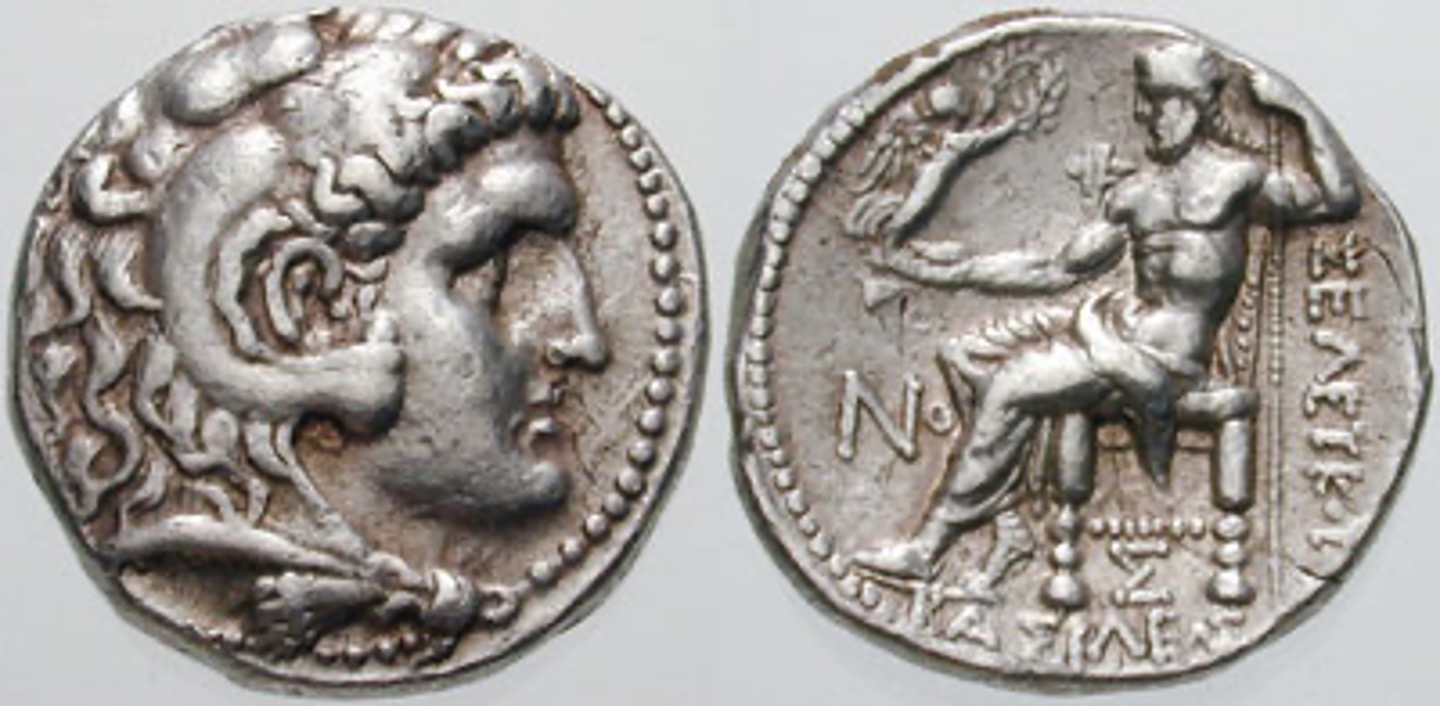3275 - Seleuceia ad Tigrim (Seleucus I) (tetradrachm Heracles/Zeus) over uncertain type (CNG, MBS 58, Sept. 2001, 691): Difference between revisions
From SILVER
No edit summary |
No edit summary |
||
| Line 16: | Line 16: | ||
|Denomination=tetradrachm | |Denomination=tetradrachm | ||
|Standard=Attic | |Standard=Attic | ||
|Coin series reference=SC I, n° 122 var. (drachm) | |Coin series reference=SC I, n° 122 var. (drachm) ; ESM, 19 (a24/p-) | ||
|Remarks=Traces of the undertype before Herakles' mouth and an anchor visible by the lion's eye | |Remarks=Traces of the undertype before Herakles' mouth and an anchor visible by the lion's eye | ||
}} | }} | ||
Revision as of 17:27, 15 May 2023
300 BCE - 295 BCE | BAΣΙΛΕΩΣ ΣΕΛΕΥΚΟΥ
Location/history
| Sale(s)Sale(s) ᵖ: | Classical Numismatic Group MBS 58, 19 Sept. 2001, n° 691. | |
Overstriking coin
Description
| ObverseInscription or printing placed on the obverse.: | Head of Herakles right, wearing lion skin headdress. Border of dots. | ReverseInscription or printing placed on the reverse.: | BAΣΙΛΕΩΣ ΣΕΛΕΥΚΟΥ (Greek) Zeus enthroned left, holding Nike stephanophoros and scepter. Under the throne, Σ. In field, NO. Border of dots. |
Mint and issuing power
| MintIdentifies the place of manufacture or issue of a numismatic object.: | Seleuceia ad Tigrim | Ancient regionAncient region. | Mesopotamia | Modern countryModern country: Iraq | AuthorityIdentifies the issuing power. The authority can be "pretended" when the name or the portrait of X is on the coin but he/she was not the issuing power. It can also be "uncertain" when there is no mention of X on the coin but he/she was the issuing power according to the historical sources: | Alexander III the Great (Argead king, 336-323 BC), Seleucus I Nicator (satrap in 321-305 BC and Seleucid king in 305-281 BC) |
Chronology
| FromIdentifies the initial date in a range assigned in a numismatic context. 300 BCE toIdentifies the final date in a range assigned in a numismatic context.. 295 BCE | hellenistic periodTime period of the numismatic object. |
Physical description
| MetalThe physical material (usually metal) from which an object is made.: Silver |
WeightWeight of the numismatic object (in grams). in grams: 17.1917.19 g <br />17,190 mg <br /> | DenominationTerm indicating the value of a numismatic object. Examples: tetradrachm, chalkous, denarius.: tetradrachm |
|
| StandardStandard.: Attic | |||
References
| Coin referenceReference of the Coin: | Coin series referenceReference to coin series study: | SC I1SC I, n° 122 var. (drachm), ESM2ESM, 19 (a24/p-) |
Overstruck type
Description
| ObverseInscription or printing placed on the obverse.: | ReverseInscription or printing placed on the reverse.: |
Mint and issuing power
| MintIdentifies the place of manufacture or issue of a numismatic object. ᵖ: | Ancient regionAncient region. ᵖ | Modern countryModern country: | AuthorityIdentifies the authority in whose name (explicitly or implicitly) a numismatic object was issued. ᵖ: |
Chronology
| FromIdentifies the initial date in a range assigned in a numismatic context. toIdentifies the final date in a range assigned in a numismatic context.. | periodTime period of the numismatic object. |
Physical description
References
| Coin type referenceReference to coin series study ᵖ: |
Additional data
| Frequency of overstrikesFrequency of overstrikes: | Level of confidenceLevel of confidence of the identification: | ||
| RemarksRemarks: | Traces of the undertype before Herakles' mouth and an anchor visible by the lion's eye | ||
References
- ^ Houghton, Arthur - Lorber, Catharine (2002), Seleucid coins : a comprehensive catalogue. Part 1, Seleucus I through Antiochus III, New York - Lancaster - London, 2 v. (xxxviii, 488 p. + 300 p.), 101 pl.
- ^ Newell, Edawrd T. (1938), The coinage of the eastern Seleucid mints, from Seleucus I to Antiochus III, Numismatic Studies 1, New York, 307 p., LVI pl.
